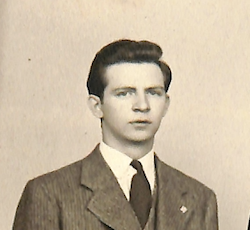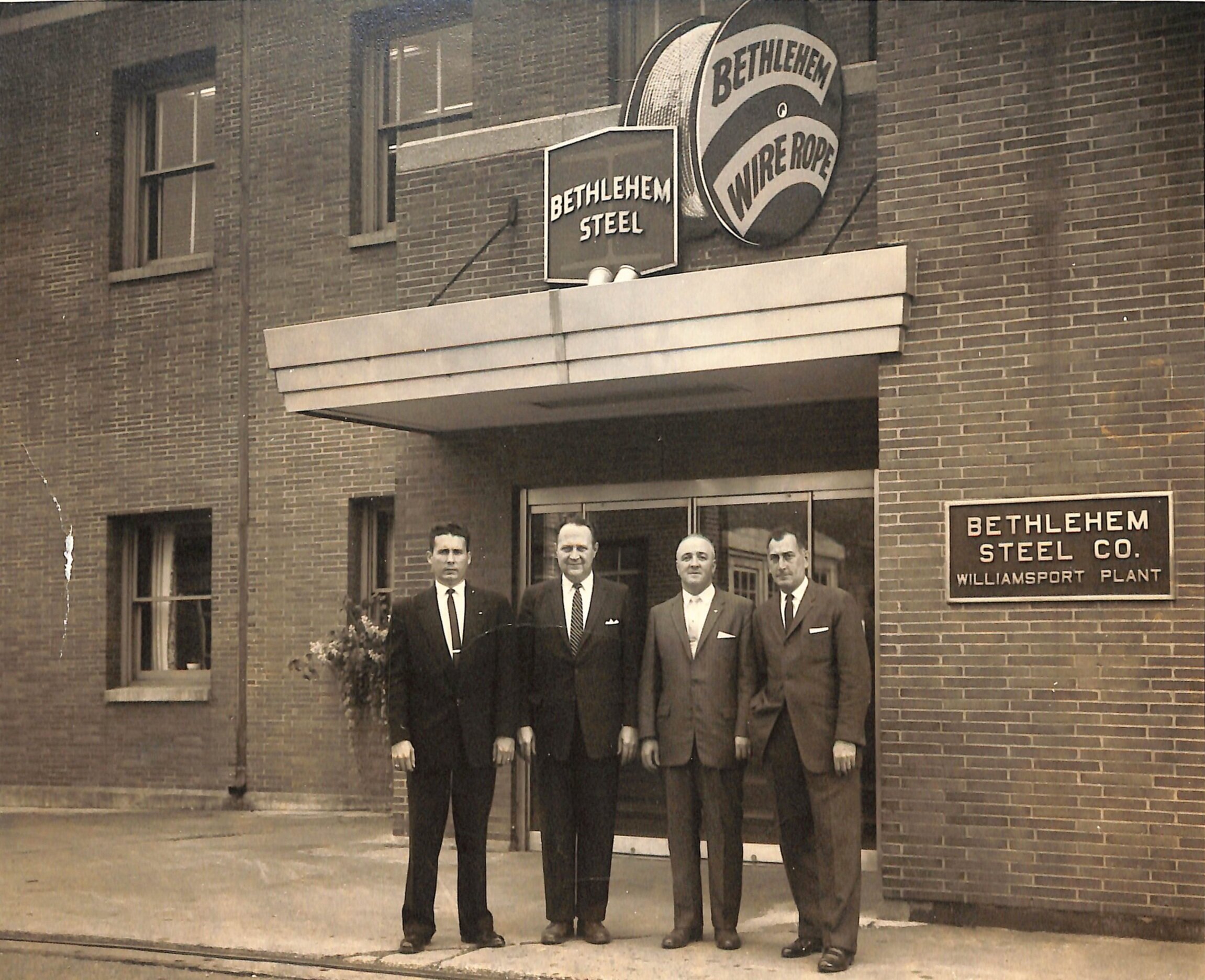An American Story, “Miksitz”
By Marisa Ishikawa, second violinist
“What do you do when you come across a fork in the road? Take it!”
Frank “Pop Pop” and Marisa
An American Story, “Miksitz,” follows the story of my grandfather, Frank Miksitz. Frank, or “Pop Pop” as I called him, was born in 1918 to Gisella Miksits (née Yandrisevits) and Frank Miksits Sr. (You may notice the spelling change between “Miksitz” and “Miksits.” This is not a mistake, just a spelling preference Frank developed and made permanent after someone accidentally misspelled Miksits with a “Z”).
Gisella and Frank Sr. were both born in Burgenland, Austria, a region on the border between Austria and Hungary. Burgenland was home to the Esterhàzy family, Hungarian nobles who ruled the region during the Austria-Hungarian empire. In 1761, the Esterhàzys hired the young Joseph Haydn as their Kapellmeister and supported him until his death in 1802. Haydn is connected to my American Story not only because of his association to Burgenland, but also because he is known as the “father of the string quartet.” I pay a small tribute to Papa Haydn and Burgenland in my music with a quote from his String Quartet Op. 76 No. 3, mvt 2, “Emperor.”
Although Gisella and Frank Sr. both left Burgenland for America in search of a better life, the two did not meet until they had both settled in Allentown, PA. Eventually, Gisella and Frank Sr. set down roots in the predominantly Austrian community, Gisella working as a homemaker and seamstress and Frank Sr. working in the cement factory (cement being the predominant industry in Allentown, PA). The young couple also started a family, Frank being the oldest followed by Stella, Helen, John, and Alfred, and also took in their nephew, Andrew.
Gisella, Frank Jr., Frank Sr.
Being the oldest boy in a poor immigrant household meant that supporting the family financially came before gaining an education. As a result, Frank stopped attending school at the age of 13 to begin working. By the time he was 18 he had ventured to New York City in search of more opportunities. In the city, Frank was able to get a job as a painter. As the story goes, Frank showed up on the first day and introduced himself to his boss. Immediately, the boss asked, “Well, what are you waiting for? Go get the truck!” Little did the boss know that Frank had never before driven a car, let alone a truck with a manual transmission. Despite his inexperience, Frank did as he was told and crawled into the driver’s seat. After much trial and error, Frank managed to coax the truck to its destination and return it safely to the garage that evening. The next day, he showed up to his job and was once again asked, “Well, what are you waiting for? Go get the truck!”
Frank and Mary
When he wasn’t working, Frank began taking night classes to earn his GED, attended concerts at Carnegie Hall, and often returned home to partake in community events. The most popular events always happened at the Saengerbund, an Austrian singing club. At these events, people would don their dirndls and lederhosen, sing songs from the home land, drink beer, and most importantly, they would polka. It was at one of these events that Frank met Mary Wukovitz for the first time.
I asked Pop Pop once how he met Grammy. He said he saw her from across the room at a polka night and knew he couldn’t be with anyone else. For their first date, Frank took Mary to Carnegie Hall to see the New York Philharmonic perform her favorite work - Richard Strauss “Der Rosenkavalier.” Despite both of their excitement, Mary fell asleep in the middle of the performance, only to be woken up by the applause at the end of the work. It was never in Frank’s nature to be annoyed. Instead, he found it hilarious and positively endearing. When Frank decided to propose to Mary, he became so nervous that he had convinced himself that she would say no. In fact, when he proposed he said, “I’m sorry, I can’t afford a nicer ring and I understand if you don’t want to accept my offer,” and began to walk away. Luckily, Mary chased after him and quickly accepted his offer. They were married September 2, 1939 (continued below).
Top (left to right): Andrew, Hellen, Stella, Frank Jr. Mary, Paul (Mary’s brother), William (Mary’s brother). Bottom (left to right): John, Frank Sr. Alfred (baby), Gisella, Mary (Mary’s mother), Ignatz (Mary’s brother).
An example of Frank’s patents
As the years passed, Frank and Mary began to set down their own roots in Nazareth, PA, a town neighboring Allentown. Frank attended and graduated from Lehigh University with a degree in civil engineering. At one point, he was even offered the opportunity to teach at his alma mater, but instead decided to continue working as a civil engineer at Bethlehem Steel Corporation and Alpha Portland Cement Company. Frank’s curiosity and passion for inventing led him to partner with his brother, Alfred, to form the U.F.I Corporation. Together, they received several patents for pollution control and soil irrigation machines, and scooter designs for public transportation. If you make it down a certain path in my story, you may even stumble upon one of his patents!
Left to right: Marie, Mary, Frank, Brenda
Frank and Mary eventually had two children, Marie (my Aunt) and Brenda (my Mom). Sadly, Mary passed away in 1970 from breast cancer, and I was never able to meet her in person. I pay tribute to her, however, in my American Story. As you may notice, my story is sprinkled with quotes from Richard Strauss’ “Der Rosenkavalier,” her favorite piece: each chapter ends with a musical quote from the work, Frank and Mary’s first dance is to the ”waltz,” and every time Frank goes to Carnegie Hall he goes to see “Der Rosenkavalier.” Although Mary passed before my time, my family kept her memory alive through stories, family photos, and of course, classical music.
To make my American Story work, I needed to create parallel universes for Frank (what would be the point if you were only allowed to make the same choices as Frank did in real life?). From my brief description of Frank’s life, I hope you now have a better sense of which branches are fact and which are fiction. However, there are still some elements in the fictional branches that are based on truth. For example, in one branch Frank witnesses a boy dive into a quarry and start to drown. This incident was based on the true story of Mary’s brother, Edward, who drowned in a quarry in 1935 at the age of 13. In reality, this incident was a few years before Frank and Mary met. However, for the story it was a way to blend fact and fiction and give Frank and Mary another opportunity to meet. Another example occurs in the branch where Frank drafts an invention for a cement factory. In reality, Frank was never a factory worker in a cement factory. However, the patent that Janet Antich incorporates into the film is indeed his own work (you can see his signature at the bottom left of the image).
Frank and his loyal dog Nick
An American Story was an incredible project to undertake. It made me explore my family history. I discovered that my ancestors came from Burgenland, that my great grandmother’s name was Gisella but she was sometimes called Stella or Estelle, and that Frank had a dog named Nick who would follow him to and from work and could find his own way home. This project also required me to compose for the very first time - an intimidating and rewarding task. There are a lot of things I learned in the process, like how I should have played through my composition on my instrument to make sure it was playable before sending it to the quartet, and how less sometimes is indeed more. I am so grateful to the quartet for their beautiful artistry, Janet Antich for bringing my family history to life, and for PNC Arts Alive for making this project possible. I hope you enjoy An American Story!




















